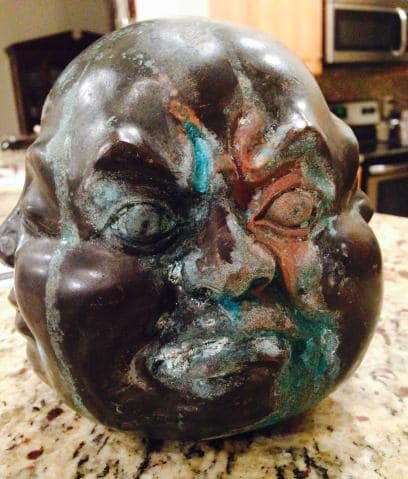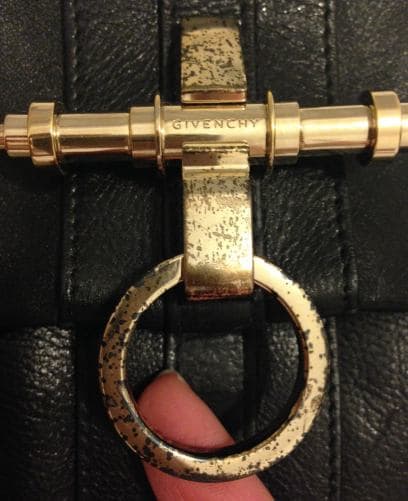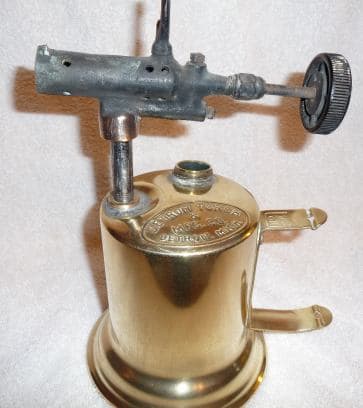
-----
Removing tarnish on brass, copper, bronze, p.2
Q. I have several different pieces of brushed finished brass. I would like to remove the tarnish from these pieces, but I have no idea what to use. For polished brass I use a Cape Cod Cloth, or Connoisseurs Polish. But I know from experience that those products will replace the brushed finishes on my pieces with a polished finish.
Any information on good products to use that will restore the luster while maintaining the brushed finish of my brass pieces would be greatly appreciated.
Hobbyist - Denver, Colorado, USA
May 8, 2014

Q. I have an old Chinese piece, probably brass or bronze, about 6" in diameter. It has a beautiful, dark green/brown patina. Unfortunately, after spending a long time in storage, it begun oxidizing in several spots, and it is quite severe. How do I remove the oxidation and restore patina? Is it possible for someone who has no experience with this kind of restoration process?
Alex Shekhtman- Jacksonville, Florida USA
March 30, 2015
Don't look at me like that, it's spooky! :-)
A. Hi Alex. Assuming it has no historical value, you can certainly try to restore it yourself. But what I'd try first is simply museum wax ... the waxing process should rub away the worst of the really loose corrosion products, and give a more consistent look to it while deterring future corrosion. If that doesn't make it "good enough" for you, you would need to re-apply a patina solution.
Regards,

Ted Mooney, P.E. RET
Striving to live Aloha
finishing.com - Pine Beach, New Jersey
Ted can be retained for immediate
answers or long term project help
April 2015
Q. Thank you very much Ted. Let me give you a bit more info. There are a few spots that "exude" some kind of clear substance, which has a consistency of light syrup. It runs down and corrodes the metal on the way. It is, probably, a chemical reaction that has to be stopped first. I am not at all familiar with museum wax and the application process, but I am afraid it may not stop the reaction.
Should I seek professional help? It is a nice piece, but it does not have much value, so, I would rather do it myself. Any suggestions?
- Jacksonville, Florida
April 5, 2015
A. Hi again. Unfortunately, I can't even guess what that corrosive substance is, or why it's oozing out. Hopefully another reader will have seen something similar.
Regards,

Ted Mooney, P.E. RET
Striving to live Aloha
finishing.com - Pine Beach, New Jersey
Ted can be retained for immediate
answers or long term project help
April 2015
A. Castings can be very porous and any trapped chemical can leak out (amongst my foundry partners and platers (brass) we surprisingly call it "leakage") through any crevice it can find once you add the patina. With copper alloys you will get the verdigris (should look and feel like crystals). It is from not properly cleaning and drying out the metal before applying the patina. The acidic water mixture will ruin a piece. You would first have to make sure you dry the piece out, if it isn't already (some people bake the piece). You can then clean it, but it will be really difficult to match the patina - lucky it isn't gold or silver plated.
I have a ton of bronze here with verdigris and often have to use a blend of various paints to match it (cheaper then replating and okay on small spots), same goes with the various bronze colors. If the piece is not valued, I would strip it (media blast) and redo the patina so it matches. You can note the same issue near your water heater when the plumber gets lazy and doesn't clean the joints properly after soldering.
Hope this added something, other then stress.
Art Deco Decor - Irvine, California
April 23, 2015
Q. Thank you very much James Pessy! I think you are right in your diagnosis. The piece was sold to me as an antique, it probably is not.
But, it is really good looking and well done. I am planning to dry it in the oven at low temperature, lets say 300 °F, then clean and apply new patina.
It is not a solid piece. The walls feel thick, but it is hollow inside, like a ball. Is it OK to put it in the oven?
Thank you again!
- Ponte Vedra Beach, Florida USA
April 28, 2015
-- apologies, finishing.com misfiled this reply, and didn't post it until June 5
A. Before having something professionally repatinated, Briwax for Bronze is a good alternative...
It cleans - but not too harshly - and won't do anything that can't be reversed.
Specifically, that very cool Chinese(?) bronze head - who knows how old it might be - really best not to do anything that can't be taken back!
I like it, anyway! :)
Scoutshouse - San Pedro, California USA
June 24, 2015

Q. I have a leather purse with gold tone hardware that I assume is lacquered brass. Part of it has severely tarnished, showing numerous black dots that do not come off with regular cleaning. Because it really looks awful, I am already willing to try polishing with brass polish, then apply lacquer.
How you'd recommend me do this?
Veneta Sakaliyska- Plovdiv, Bulgaria
April 28, 2015
A. Veneta,
It's always difficult to tell for certain from a photograph, but to me it looks more like a coating that is failing and revealing the metal underneath.

Ray Kremer
Stellar Solutions, Inc.
McHenry, Illinois

June 5, 2015

Q. Hi:
I could use some help in cleaning up severe tarnish from a 'old' plumber's blow torch. The fuel reservoir and the pressure pumping mechanism cleaned up very well with Brasso
⇦ on
eBay
or
Amazon [affil link] .
Then, I discovered that the 'flame' nozzle assembly was ALSO brass. It is so thickly coated it almost looks like cast iron. (But, if you look closely at the bottom of the assembly, where it screws into the reservoir, you'll see some brass trying to shine through.
It seems to me to be a monumental undertaking.
Can you recommend something?
TIA,
Bob
- La Jolla, California, USA
A. Normally I suggest a mild acid such as citric for getting tarnish off of brass. With how that looks, it might need either a very long soak in a mild acid, or an acid that isn't quite so mild. Phosphoric has a little more kick to it while still not being overly dangerous to work with.

Ray Kremer
Stellar Solutions, Inc.
McHenry, Illinois

June 5, 2015
![]() Ray:
Ray:
Thanks a million. I'll try it.
Bob
- La Jolla, California, USA
June 7, 2015
Q. I have a Pavoni expresso machine which I have stablished that the boiler is of brass, with chromium on the outside to enhance its appearance and to minimise heat loss. unscrewing the lid of the bolier reveals green. Any ideas on how to get rid of it?
Alan Frei- Teddington, Middlesex, England
June 21, 2015
Tarnish on brass tube in precision optical assembly
Q. I have a question about removing what I believe is tarnish on brass tubes used in a precision optical assembly. We currently magnetically de-burr these tubes, which removes burrs from the machining process and has the added benefit of scrubbing the ID of our tubes to make them pretty clean. After magnetic de-burring, we ultrasonically clean the tubes in a nitric acid solution. We still have about 10% of our tubes that are dirty after ultrasonic cleaning. We can tell because we clean the ID with a swab moistened with methanol [affil link], and the swabs from about 10% of the tubes are dirty after our check. Is there a better solvent/detergent to use for cleaning these tubes?
Paul Van Wagner- Traverse City Michigan
July 21, 2015
Marks in my copper
Q. Dear all,
I have recently purchased a lovely victorian copper kettle. I have had great success cleaning it inside from advice on google and this site, I have also made leaps on the outside shine on this beautiful kettle. Using both a lemon/salt and boiling out in vinegar
⇦in bulk on
eBay
or
Amazon [affil link] /salt methods then finishing with a commercial polish then kettle is gleaming nicely, however, I cannot remove what I describe as black scars/blemishes found around the kettle. No amount of scrubbing seems to be taking it away, though it looks possible!
Any advice greatly appreciated,
Josh
- Barnet, ENGLAND
July 26, 2015
Large Copper Kettles on eBay
A. Hi Josh,
Sounds to me like black copper oxide from excessive heating or burnt on carbon from a yellow flame from a fire or stove. Any chemical treatment is likely to need aggressive chemicals and not recommended for home use. Also there is no guarantee of success. I would try rubbing with a fine emery paper. Use the finest grit that will do the job. You will have to polish out the scratches left by the emery to get a uniform finish. Test the routine on an inconspicuous area first!
Harry

Harry Parkes
- Birmingham, UK
August 2, 2015
![]() Thank you very much for your response. I will try this and let you know how I get on!
Thank you very much for your response. I will try this and let you know how I get on!
Cheers,
Josh
- Barnet, ENGLAND
August 4, 2015
![]() Harry - thank you very much for the advice.
Harry - thank you very much for the advice.
I ordered some "micromesh" abrasive sheets and have done the job perfectly.

A bit of elbow work with this removed all the blemishes and the tarnish, but then a traditional polish has buffed it up to a remarkable finish, though how long for I don't know!
Thanks again Harry, very happy kettle here!
- Barnet, ENGLAND
August 6, 2015
Good. Thanks for letting me know Josh.
Harry

Harry Parkes
- Birmingham, UK
August 8, 2015
Q, A, or Comment on THIS thread -or- Start a NEW Thread